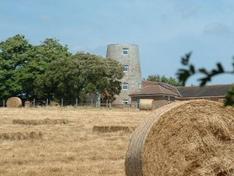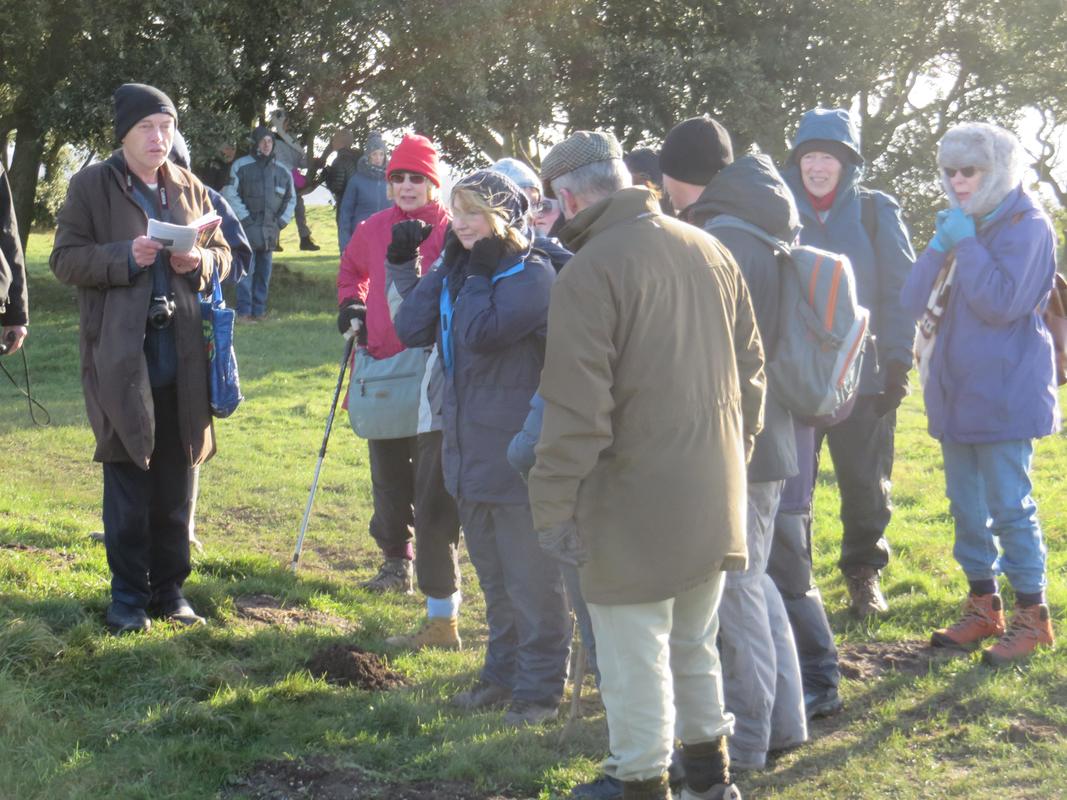
The National Trust tells us that ‘winter is the best time to wrap up warm, throw on some wellies and go for an invigorating walk’ and this is how a group of 16 WAS members, wearing our warmest layers, celebrated the New Year on January 7th.
We chose a simple but favourite 3 mile route from Angmering to Highdown and back again ending up at the cosy traditional pub The Spotted Cow for drinks and lunch. We crossed the A280 dual carriageway via the footbridge and along Ecclesden Lane passing the historic Ecclesden Manor House with a view of Ecclesden Mill beyond.
The manor house is a Grade 2 listed building was first recorded in 1324 and rebuilt by John Forster in 1634. ‘Two storeys and attic. Seven windows. Faced with flints and some red brick. Horsham slab roof, partly replaced with tiles. Casement windows with stone mullions. Central gable with kneelers and ball finials raised aloft on iron uprights resting on brick and stone piers. Round-headed doorway with pilasters and keystone over. Modern additions to north’ [britishlistedbuildings.co.uk] This beautiful 7 bedroom 5 reception house is currently up for sale for a just under 3 million pounds – the description and images in the Savills brochure are astonishing (where’s my lottery ticket!). You can read more about Ecclesden, the manor, village and farm, the owners and tenants in Angmering Village Life http://www.angmeringvillage.co.uk
A little further along the lane and on the hill behind the manor is the once ‘topless’ windmill known as the Ecclesden Mill or Highdown New Mill. There have been several mills including a watermill built on or near to this site over the centuries but this one was built in 1826. It had a very short life as it was only working until 1872. ‘In 1880, the cap and sails were blown off.
By the 1930s the mill was an ivy clad ruin. It was converted into a house in the early 1970s’ [Highdown New Mill in Wikipedia]
The former mill and attached house are also currently for sale and Strutt and Parker describe it as ‘a truly unique property’. The owners have also re-capped the mill so it doesn’t look quite as quirky as the photo from Wikipedia.
We continued on our walk and soon the neat lane turned into a deep furrowed muddy track. We passed a large chalk pit to the left of the path which is named on an 1875 map as ‘the old chalk pit’ and now has a fine modern house and stables with landscaped gardens built in it.
Highdown Hill began to appear above the trees and we knew that sooner or later we would have to leave the relatively sheltered path and stride out into the wind and climb to the summit. Our leg muscles soon began to groan, the altitude of the brow is about 81 metres, and Jennie suggested that we walk backwards to ease the pain! The views from the top were stunning - you could see as far as Beachy Head one way, Arundel Castle and the spire of Chichester Cathedral the other.
We stood within the ramparts listening to Brenden's fascinating and thought-provoking talk about the early evidence of the Hillfort from Bronze Age through to Iron Age. He also told us about the extensive Saxon burial ground that was excavated in 1872 and the artifacts that were found. Alex explained his theory of flint mines that could possibly be hidden within the Hillfort area. He pointed out the known flint mining areas such as Cissbury, Church Hill and Blackpatch visible from our vantage point. The group discussed the ancient track-ways, possible barrows and other earthworks and, of course, the Roman Bath House that was excavated by Worthing Archaeological Society in 1937/38.
After paying our respects to the ‘Miller’ and admiring his tomb, we headed back down the slope. We searched for the lime kilns on the 1875 map (we’ll find them next time Connie) and crossed the Bath House field, through swamps and marshes and barbed wire fences to Angmering and our friends in the pub.
Thank you to all of the valiant walkers and brilliant speakers, to Keith for sending us his notes and illustrations and to Gill who had us all kicking over mole hills in search of flint tools and Roman pottery.
The AA describes our New Year’s route as a ‘bracing hilltop walk’ and it was positively invigorating in the cold easterly January winds.
We chose a simple but favourite 3 mile route from Angmering to Highdown and back again ending up at the cosy traditional pub The Spotted Cow for drinks and lunch. We crossed the A280 dual carriageway via the footbridge and along Ecclesden Lane passing the historic Ecclesden Manor House with a view of Ecclesden Mill beyond.
The manor house is a Grade 2 listed building was first recorded in 1324 and rebuilt by John Forster in 1634. ‘Two storeys and attic. Seven windows. Faced with flints and some red brick. Horsham slab roof, partly replaced with tiles. Casement windows with stone mullions. Central gable with kneelers and ball finials raised aloft on iron uprights resting on brick and stone piers. Round-headed doorway with pilasters and keystone over. Modern additions to north’ [britishlistedbuildings.co.uk] This beautiful 7 bedroom 5 reception house is currently up for sale for a just under 3 million pounds – the description and images in the Savills brochure are astonishing (where’s my lottery ticket!). You can read more about Ecclesden, the manor, village and farm, the owners and tenants in Angmering Village Life http://www.angmeringvillage.co.uk
A little further along the lane and on the hill behind the manor is the once ‘topless’ windmill known as the Ecclesden Mill or Highdown New Mill. There have been several mills including a watermill built on or near to this site over the centuries but this one was built in 1826. It had a very short life as it was only working until 1872. ‘In 1880, the cap and sails were blown off.
By the 1930s the mill was an ivy clad ruin. It was converted into a house in the early 1970s’ [Highdown New Mill in Wikipedia]
The former mill and attached house are also currently for sale and Strutt and Parker describe it as ‘a truly unique property’. The owners have also re-capped the mill so it doesn’t look quite as quirky as the photo from Wikipedia.
We continued on our walk and soon the neat lane turned into a deep furrowed muddy track. We passed a large chalk pit to the left of the path which is named on an 1875 map as ‘the old chalk pit’ and now has a fine modern house and stables with landscaped gardens built in it.
Highdown Hill began to appear above the trees and we knew that sooner or later we would have to leave the relatively sheltered path and stride out into the wind and climb to the summit. Our leg muscles soon began to groan, the altitude of the brow is about 81 metres, and Jennie suggested that we walk backwards to ease the pain! The views from the top were stunning - you could see as far as Beachy Head one way, Arundel Castle and the spire of Chichester Cathedral the other.
We stood within the ramparts listening to Brenden's fascinating and thought-provoking talk about the early evidence of the Hillfort from Bronze Age through to Iron Age. He also told us about the extensive Saxon burial ground that was excavated in 1872 and the artifacts that were found. Alex explained his theory of flint mines that could possibly be hidden within the Hillfort area. He pointed out the known flint mining areas such as Cissbury, Church Hill and Blackpatch visible from our vantage point. The group discussed the ancient track-ways, possible barrows and other earthworks and, of course, the Roman Bath House that was excavated by Worthing Archaeological Society in 1937/38.
After paying our respects to the ‘Miller’ and admiring his tomb, we headed back down the slope. We searched for the lime kilns on the 1875 map (we’ll find them next time Connie) and crossed the Bath House field, through swamps and marshes and barbed wire fences to Angmering and our friends in the pub.
Thank you to all of the valiant walkers and brilliant speakers, to Keith for sending us his notes and illustrations and to Gill who had us all kicking over mole hills in search of flint tools and Roman pottery.
The AA describes our New Year’s route as a ‘bracing hilltop walk’ and it was positively invigorating in the cold easterly January winds.

